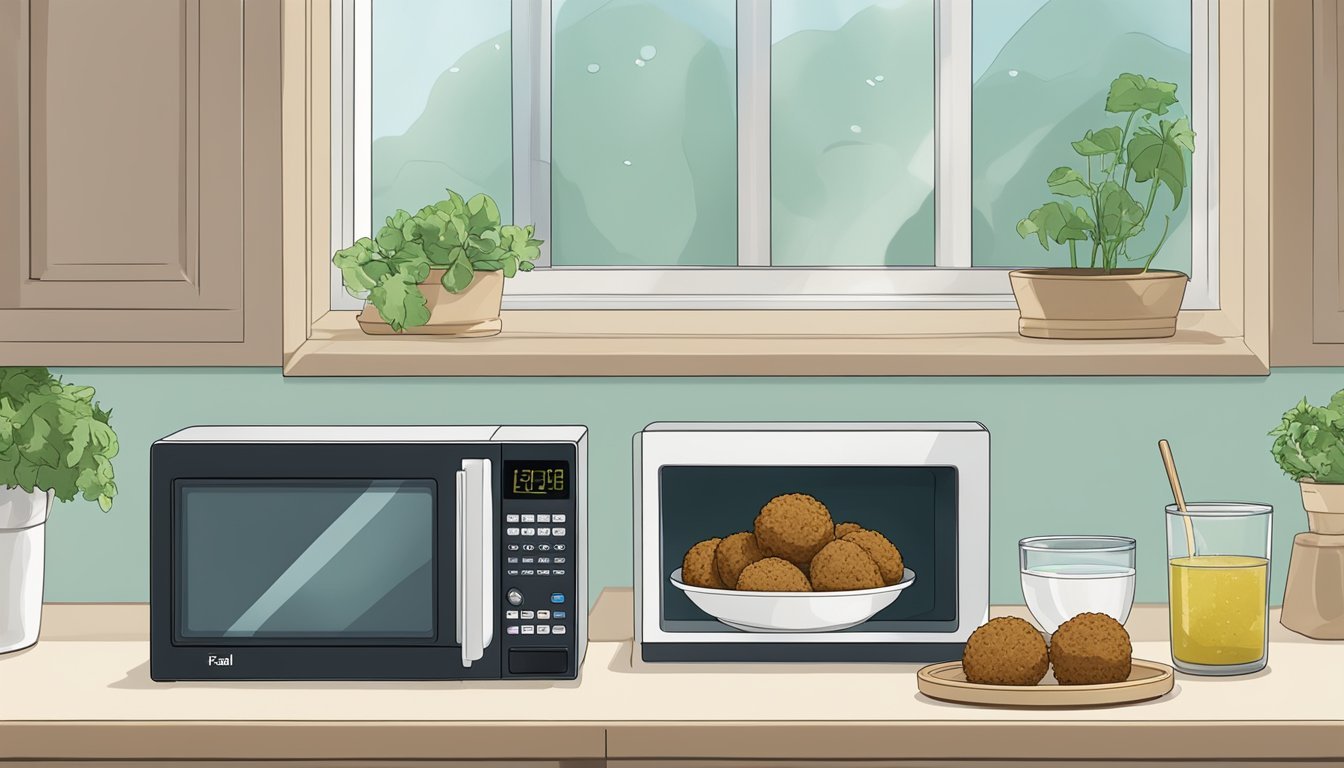Best Way to Reheat Falafel
Keeping It Moist and Delicious
Falafel, the traditional Middle Eastern dish made of ground chickpeas or fava beans, has gained worldwide popularity for its rich flavor and versatility. While falafel is best enjoyed fresh, there are times when leftovers are inevitable. The challenge then becomes reheating falafel without compromising its taste and texture. Many falafel enthusiasts often struggle to find a reheating method that preserves the dish's signature crisp exterior and moist interior without drying it out.
Several reheating techniques can be employed to ensure falafel retains its quality. The key is gentle heat application and protection from direct hot air, which can extract moisture and lead to a dry, unappealing texture. Whether using an oven, air fryer, or skillet, factors like temperature control and reheating duration play pivotal roles. Consideration of these factors transforms leftover falafel into a dish that can nearly rival its freshly-made counterpart in both taste and texture.
Understanding Falafel and Its Cooking Essentials
Falafel is a traditional Middle Eastern dish that's both highly nutritious and versatile, often enjoyed as a street food snack, appetizer, or main course. With its rich history and unique combination of ingredients, understanding the essentials of cooking falafel is crucial to enjoying it at its best.
History and Significance of Falafel
Originating from the Middle East, falafel has become a world-renowned vegetarian dish. Made primarily from chickpeas or fava beans, this staple food has been served for centuries, often as a quick, portable snack. Its presence is integral to Middle Eastern cuisine, and it has significant cultural and historical value.
Key Ingredients: Chickpeas and Fava Beans
The base of falafel is typically ground chickpeas, fava beans, or a combination of both. These legumes are not only rich in protein and fiber, but they also give falafel its characteristic hearty texture. After soaking, they are ground to a coarse paste, forming the foundation of the falafel mixture.
The Role of Spices and Herbs in Flavor
Spices and herbs are essential in falafel for adding depth of flavor and aroma. Common seasonings include:
Cumin: For a warm, earthy note.
Coriander: Adds a citrusy, nutty essence.
Garlic: For robust zest.
Parsley: Brings a fresh, slightly peppery taste.
These ingredients, among others, combine to create the distinctive taste that falafel is famous for.
Falafel as a Nutritious Vegetarian Meal
As a vegetarian meal, falafel is not only filling but also highly nutritious. It offers a good source of plant-based protein, essential for vegetarians and those seeking meat alternatives. The fiber content aids in digestion, while the inclusion of herbs and spices contributes additional nutrients and antioxidants. Its versatility allows it to be served in various forms, be it as a snack or part of a balanced meal.
Preserving Falafel's Freshness and Quality
Keeping leftover falafel fresh involves proper storage techniques that maintain its moisture while ensuring it doesn't become soggy or develop freezer burn during refrigeration or freezing.
Storing Leftover Falafel
When one has leftover falafel, they should store them in an airtight container. This prevents excess air from drying out the falafels and helps maintain their freshness for later consumption.
Room Temperature: Store in a cool, dry place for a few hours.
Refrigerate: Place in an airtight container and refrigerate to keep fresh for the short term.
Refrigeration vs. Freezing Techniques
The decision between refrigeration and freezing depends on how long one intends to store the falafel. Cooked falafels kept in the refrigerator will remain fresh for a couple of days, while the freezer can extend their life span.
Refrigeration:
Duration: Up to 2-3 days
Container: Airtight container to retain moisture
Freezing:
Duration: Up to 3 months
Wrap: Use cling film or place them in a zip-lock bag before storing in a container.
Preventing Freezer Burn and Soggy Textures
When freezing falafel, one must ensure to remove as much air as possible to prevent freezer burn. A soggy texture can be avoided by fully cooling the falafels before storage and not thawing them unnecessarily.
Technique:
Cool falafels completely before storing.
Wrap each falafel individually in cling film.
Place them in a zip-lock bag, squeezing out excess air.
Store in the freezer in an airtight container.
Following these careful storage methods, whether refrigerating or freezing, will help in preserving the texture and flavor of falafel, ensuring that even reheated falafels can still provide a satisfying crispness and taste akin to fresh food.
Optimal Methods for Reheating Falafel
Reheating falafel requires careful attention to preserve its crispy exterior and flavorful interior. Each method outlined below targets a balance between maintaining a crispy texture while ensuring the falafel is heated through.
Using the Oven for Even Heating
The oven is ideal for evenly reheating falafel, efficiently warming them up without sacrificing their texture. For the best results:
Preheat the oven to 350°F (175°C).
Place the falafel on a baking sheet, spaced apart to allow proper airflow.
Heat for approximately 5-10 minutes.
This method enables the falafel to regain a crunchy exterior with thorough heating.
Skillet Reheating for Crispy Exterior
A skillet can provide the falafel with a crispy exterior reminiscent of the initial fry. To use this method:
Heat a small amount of oil over medium heat.
Add falafel to the skillet, ensuring they are not overcrowded.
Turn them frequently for 2-3 minutes, or until they are evenly browned and warm.
The direct heat from the skillet method crisps the falafel's exterior for a satisfying texture.
Microwave Method for Quick Reheating
When time is of the essence, the microwave can be used for rapid heating, though it may slightly compromise crispness:
Place falafels on a microwave-safe plate.
Heat on high for 30-60 seconds, checking for warmth.
The microwave method is the quickest way to reheat falafel but it isn't the best choice for preserving a crispy exterior.
Air Fryer Technique for Crispiness
An air fryer excels at reheating falafel while enhancing its crispiness due to the equipment's design which circulates hot air around the food:
Preheat the air fryer to 350°F (175°C).
Arrange falafel in the basket, separated to promote circulation.
Heat for 2-3 minutes, shaking the basket halfway for even crispness.
This method achieves a crispy finish with less oil, delivering results similar to deep frying.
Best Practices for Maintaining Quality During Reheating
To ensure that reheated falafel retains its crispy texture and juiciness without becoming soggy or drying out, follow these specific best practices that address oil management, airflow, and the use of kitchen aids like aluminum foil and paper towels.
Managing Oil Usage and Moisture
When reheating falafel, it's crucial to strike the right balance with oil to maintain moisture without making the falafel greasy. For oven baking, lightly brush the falafel with oil before placing them on a baking tray lined with parchment paper. In a frying pan, heat a small amount of oil, sufficient to cover the base, before adding the falafel, ensuring they are not submerged in oil which can lead to excess absorption and a greasy texture.
Avoiding Overcrowding and Ensuring Airflow
Crowding the falafel on a plate or tray can lead to uneven heating and steam build-up, making them soggy. To maintain crispiness, place them in a single layer with enough space between each on a baking tray. For air frying, ensure the balls aren't touching, allowing hot air to circulate freely around each falafel, crisping them evenly.
The Use of Aluminum Foil and Paper Towels
Wrapping falafel in aluminum foil can prevent them from drying out when reheated in an oven. However, they should be wrapped loosely to allow some moisture to escape and avoid a steamy environment. Additionally, placing a damp paper towel over falafel when reheating in a microwave can help maintain moisture without sacrificing texture, but be sure to leave a small opening for steam to vent.
Creative Culinary Uses for Reheated Falafel
Reinvigorating the taste and texture of reheated falafel can transform it into a range of delightful dishes. This section explores various ways to utilize reheated falafel in meals, complementary pairings, and innovative serving ideas, each enhancing its distinct flavors and crispy exterior.
Transforming Falafel into New Meals
Reheating falafel presents an opportunity to be inventive with meal creation. For a main course, consider breaking up reheated falafel into spiced falafel crumbles over a bed of fragrant rice; the blend of spices in the falafel will infuse the rice with a savory dimension. Alternatively, add these crumbles to a stuffed vegetable dish, such as bell peppers or zucchini boats, for a Mediterranean-inspired entrée.
Rice Bowl: Reheated falafel crumbles, rice, fresh parsley
Stuffed Peppers: Bell peppers, falafel crumbles, vegetables
Pairing Falafel with Complementary Dishes & Sides
Pairing reheated falafel with the right dishes and sides can elevate the overall taste experience. A falafel wrap or falafel sandwich in pita bread with a generous drizzle of tahini sauce or a dollop of hummus balances the flavors and adds creaminess. For a lighter option, pair reheated falafel with a fresh salad, mixing in plenty of fresh vegetables and spices to complement the falafel's robust character.
Falafel Wrap: Pita bread, tahini, vegetables, reheated falafel
Salad Pairing: Mixed greens, falafel, hummus, parsley
Innovative Serving Suggestions for Falafel
Reheated falafel can star in an array of innovative serving suggestions. Use them to top a vegan pizza, replacing traditional toppings with these crunchy morsels. Or, reimagine an appetizer platter by placing reheated falafel atop a spoonful of tahini, garnished with fresh parsley. This not only preserves the falafel's crispy exterior but also impresses with a unique presentation.
Falafel Pizza: Vegan crust, reheated falafel, tahini, vegetables
Falafel Platter: Individual falafel, tahini sauce, parsley garnish
Employing reheated falafel in these creative ways maintains its essence while providing a canvas for an array of delicious and inviting culinary explorations.
Aftercare and Future Preparation Tips
Maintaining the quality of falafel when reheating begins with proper aftercare and effective preparation strategies. This section explores the optimal methods for oil disposal after frying and how to best plan ahead for falafel meals.
Proper Disposal of Frying Oil
After deep frying falafel, disposal of the used oil is a critical step. Allow the oil to cool completely before transferring it to a non-recyclable container, such as a sealed plastic bottle. Dispose of it with regular waste, ensuring not to pour it down the drain to avoid plumbing issues. It's vital for the health of kitchen equipment, as well as environmental considerations.
Planning Ahead for Falafel Meals
For those who adore falafel, planning for future meals can save time and retain flavor. To store falafel, let them cool after cooking, and wrap them individually in aluminum foil or place them in a freezer-safe bag to avoid freezer burn.
Fridge Storage: If you plan to eat the falafel within a day or two, wrap them in plastic wrap and store them in the refrigerator to maintain freshness.
Freezer Storage: For longer storage, freeze the falafel in a single layer on a baking sheet before transferring to a freezer bag; this prevents them from sticking together. They can be stored frozen for up to one month.
When it's time to reheat, placing frozen falafels in a non-stick skillet on the stovetop or in a preheated oven will revive them to their original crispness. Be cautious not to overheat as this can dry them out. A cast iron skillet can also be used for reheating on the stovetop, providing an evenly heated surface.
Conclusion
Falafel is renowned for its delightful crunch and savory flavor, which can be compromised if not reheated correctly. To ensure that reheated falafel maintains its desirable texture and taste, one should consider the method that best suits their convenience and equipment.
The air fryer method emerges as a top choice for its ability to uniformly circulate hot air around the falafel, reviving its crispiness without dryness. Users should preheat their air fryer to 350°F (180°C) and heat the falafel for 2-3 minutes. However, one must ensure that the falafel is not overcrowded in the basket to allow even reheating.
Alternatively, the oven method remains popular due to its widespread availability. Wrapping falafel in foil and reheating at 350 degrees F for 5-10 minutes is effective, and it prevents moisture loss.
For individuals seeking a quick solution, the skillet method, with a modest amount of oil over medium-high heat, can bring back the falafel's crispiness efficiently.
The key takeaway is to heat the falafel just until it reaches the desired warmth, avoiding extended cooking times that lead to dryness. By following these methods, diners can enjoy falafel that is as close to freshly made as possible.







